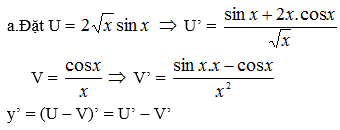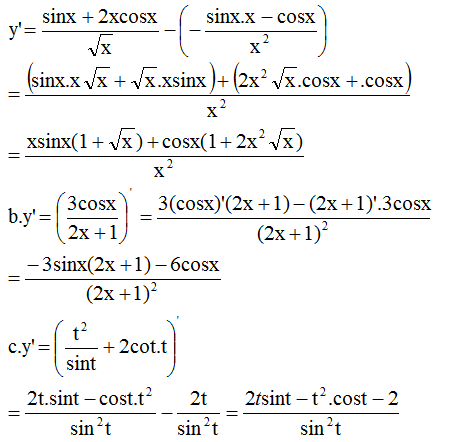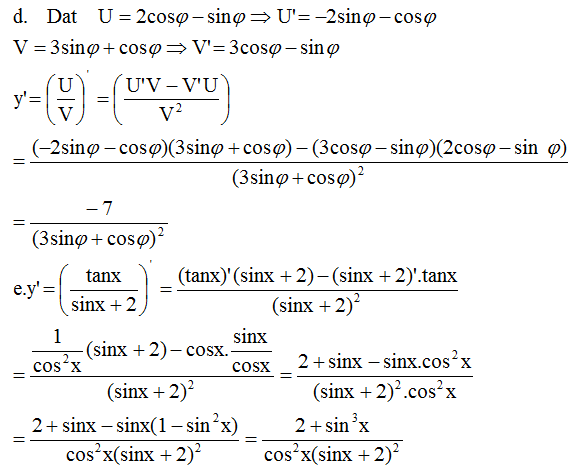Hãy nhập câu hỏi của bạn vào đây, nếu là tài khoản VIP, bạn sẽ được ưu tiên trả lời.

1.
Kiểm tra lại đề bài, câu này phải là \(\dfrac{sinx+2cosx+3}{2sinx+cosx+3}\) mới đúng
2.a
ĐKXĐ: \(cosx\ne0\)
\(\Leftrightarrow\dfrac{1}{cos^2x}=4tanx+6\)
\(\Leftrightarrow1+tan^2x=4tanx+6\)
\(\Leftrightarrow tan^2x-4tanx-5=0\)
\(\Leftrightarrow\left[{}\begin{matrix}tanx=-1\\tanx=5\end{matrix}\right.\)
\(\Leftrightarrow\left[{}\begin{matrix}x=-\dfrac{\pi}{4}+k\pi\\x=arctan\left(5\right)+k\pi\end{matrix}\right.\)
2b.
Đặt \(x-\dfrac{\pi}{4}=t\Rightarrow x=t+\dfrac{\pi}{4}\)
\(sin^3t=\sqrt{2}sin\left(t+\dfrac{\pi}{4}\right)\)
\(\Leftrightarrow sin^3t=sint+cost\)
\(\Leftrightarrow sint\left(1-cos^2t\right)=sint+cost\)
\(\Leftrightarrow sint.cos^2t+cost=0\)
\(\Leftrightarrow cost\left(sint.cost+1\right)=0\)
\(\Leftrightarrow\left[{}\begin{matrix}cost=0\\sin2t=-\dfrac{1}{2}\end{matrix}\right.\)
\(\Leftrightarrow\left[{}\begin{matrix}cos\left(x-\dfrac{\pi}{4}\right)=0\\sin\left(2x-\dfrac{\pi}{2}\right)=-\dfrac{1}{2}\end{matrix}\right.\)
\(\Leftrightarrow\left[{}\begin{matrix}cos\left(x-\dfrac{\pi}{4}\right)=0\\cos2x=\dfrac{1}{2}\end{matrix}\right.\)
\(\Leftrightarrow...\)

Chứng minh các biểu thức đã cho không phụ thuộc vào x.
Từ đó suy ra f'(x)=0
a) f(x)=1⇒f′(x)=0f(x)=1⇒f′(x)=0 ;
b) f(x)=1⇒f′(x)=0f(x)=1⇒f′(x)=0 ;
c) f(x)=\(\frac{1}{4}\)(\(\sqrt{2}\)-\(\sqrt{6}\))=>f'(x)=0
d,f(x)=\(\frac{3}{2}\)=>f'(x)=0




a.
Đặt \(y=\dfrac{2sinx+cosx}{sinx-cosx+3}\)
\(\Leftrightarrow y.sinx-y.cosx+3y=2sinx+cosx\)
\(\Leftrightarrow\left(2-y\right)sinx+\left(y+1\right)cosx=3y\)
Theo điều kiện có nghiệm của pt lượng giác bậc nhất:
\(\left(2-y\right)^2+\left(y+1\right)^2\ge9y^2\)
\(\Leftrightarrow7y^2+2y-5\le0\)
\(\Leftrightarrow-1\le y\le\dfrac{5}{7}\) (đpcm)
b.
Hoàn toàn tương tự câu a:
Đặt \(y=\dfrac{2sinx+cosx+2}{2cosx-sinx+4}\)
\(\Leftrightarrow2y.cosx-y.sinx+4y=2sinx+cosx+2\)
\(\Leftrightarrow\left(y+2\right)sinx+\left(1-2y\right)cosx=4y-2\)
Theo đk có nghiệm pt lượng giác bậc nhất:
\(\left(y+2\right)^2+\left(1-2y\right)^2\ge\left(4y-2\right)^2\)
\(\Leftrightarrow11y^2-16y-1\le0\)
\(\Leftrightarrow\dfrac{8-5\sqrt{3}}{11}\le y\le\dfrac{8+5\sqrt{3}}{11}\)
Đề bài chắc sai, em kiểm tra lại số liệu đề câu b nhé